Review: ‘The Great Gatsby’ Is Now an Immersive Play—or Is It a Party?
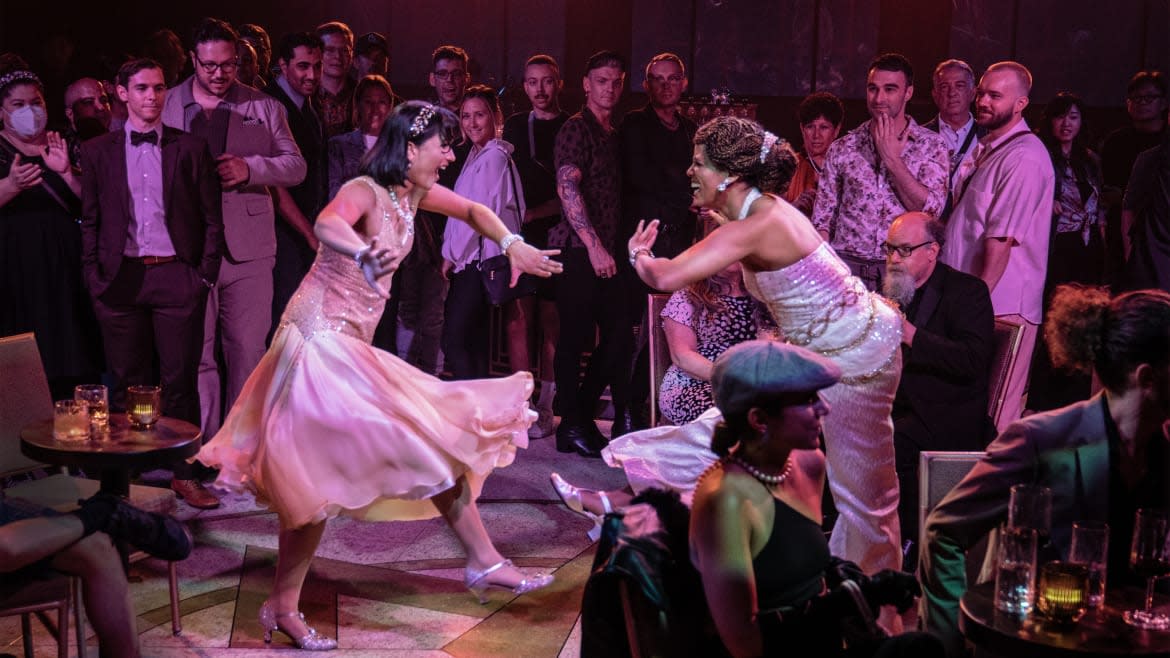
- Oops!Something went wrong.Please try again later.
Nick Carraway is seeking suggestions for the perfect seduction move.
“Glass of champagne,” one of these reporters replies in a far more panicked tone than they have ever considered a glass of champagne. A moment later, a little group of us are with Nick (Rob Brinkmann), Myrtle Wilson (Claire Saunders), and Tom Buchanan (Shahzeb Hussain), as the latter two cavort—both behind their married partners’ backs. Hussain has Buchanan’s brutal bluffness down pat. Our little group are laughing one minute, then mortified, then a little freaked out, and soon sworn to silence over what we have seen. And then it’s on to the next strange encounter.
Such is the world of Immersive Everywhere’s production of The Great Gatsby—The Immersive Show (booking to Dec. 3). Outside the Park Central Hotel on New York City’s Seventh Avenue, a few blocks south of Central Park, it is a steamy Saturday afternoon. Inside we are asked to line up on a red carpet, and then ushered downstairs into the “Gatsby Mansion,” as in Jay Gatsby, F. Scott Fitzgerald’s suave avatar for the Jazz Age. Some audience members are in their 2023 civvies, some are dressed up in full dapper, Flapper glory. Vanessa Leuck’s costumes for the performers are slick, spiffing, and sexy.
The Problem With The Great Gatsby’s Daisy Buchanan
Around 16,000 square feet of unused ballroom space has been Gatsby-ishly made over by Shoko Kambara’s skilful art direction, production designer Casey Jay Andrews, decorator and prop supremos Faye Armon-Troncoso, Lauren Helpern, and Butter Designs, along with Jeff Croiter’s lighting (yes, that famous green light at the end of the dock is done very effectively). Big set pieces take place in a main ballroom space, with around its edges and darkened corridors—as in Sleep No More‚ and other such enterprises—period-perfect furnished rooms where micro-dramas are played out for small groups of audience members.
The idea: Choose a Gatsby character or characters, choose an unfolding drama, and follow them. (In fact, the shepherding of the audience feels a little more formalized and orderly than other immersive productions.) Be prepared for characters to speak to you, and be ready to be asked to undertake tasks—some arduous, as in the young audience members who suddenly became floor sweepers to prepare for Gatsby’s (Joél Acosta) swoonily flirty afternoon tea with Daisy (Jillian Anne Abaya).
The New York Times reported that you would need to go to the show about 10 times to see it in its entirety—and it’s a two-and-a-half hour show. If you have the funds (it’s around $80 a ticket) and devotion to do so, good luck! The Daily Beast went once. Having sat through the masterfully executed experience of Gatz, these reporters were first struck—at least in the stories they followed, and what they observed in the main room—that the deeper strains and social-critique aspects of the book seemed to have been mostly jettisoned.
Despite the deaths and general tragedy that mount up towards the end, the vibe is P-A-R-T-Y, helped in no small way by a central bar characters dance on and audience members drink from (the bartenders deserve their own shoutout). Is the influence of Baz Luhrmann’s pizzazzy, propulsive movie present? Is that the Gatsby theater-going expectation?
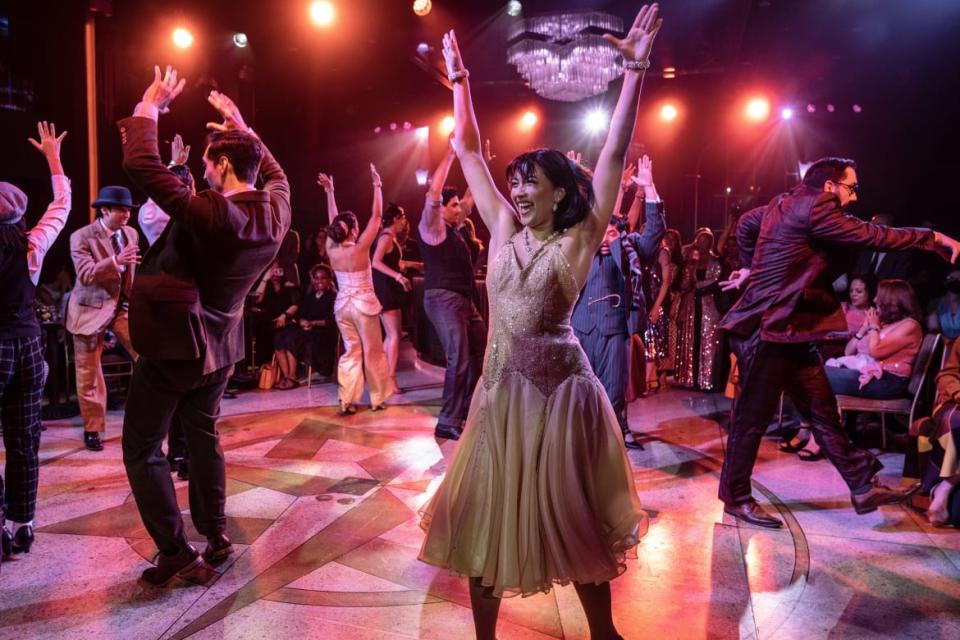
There is lushly played era-specific music—the original score was composed and produced by Glen Andrew Brown and Tendai Humphrey Sitima, with arrangements and additional composition by David Sims—and whizzing choreography overseen by Holly Beasley-Garrigan, which you are encouraged to join in with. As the revelry ramps up at the beginning, we’re all waiting to catch a glimpse of the man himself, our fabulously wealthy and mysterious host, the elusive Gatsby.
The electricity between Abaya and Acosta is palpable, and the audience is quickly and deeply invested in their love story. By the time we get to Gatsby preparing for tea with Daisy—tying and retying his tie and freaking out about the flower arrangements—the audience is shouting helpful tips to him. (“Mr. Gatsby, the rug!” one spectator yelled with panic when the carpet bunched up under the tea table.)
We, too, want the long-awaited reunion between this ex-poor boy soldier and his society-girl muse to be perfect. He’s worked so hard and waited for so long, after all. He made something of himself against all odds—now he’s no longer just “some nobody” whom Daisy’s parents forbid her from marrying. He’s so successful he can buy those rubies and fine shirts and tiger skins, that mansion with the period bathrooms, those fine rare things, yet all poor substitutes for true love.
It’s all rewarded the moment their eyes meet. A hush falls on the room. Yes, she’s the green light and now he’s not just reaching for it across the bay, he’s arrived. But their happiness is short-lived, because he’s built his fortune by illicit means, and because Daisy is fickle, and because once you reach the green light, your count of enchanted objects in the world has “diminished by one.”
When Gatsby realizes this—in the claustrophobic and booze-soaked apartment where he and Nick and Tom and Jordan and Daisy sweat away a sweltering summer night—and he absorbs that Daisy is not going to tell her boorish husband that she never loved him, that perhaps she even forget about Gatsby for a time—even as he had decked out his love for her with “fire and freshness,” with every “bright feather that drifted his way”—he panics, Daisy retreats, and the wheels of tragedy are set in motion as the quintet rush back to their mansions through the Valley of Ashes.

Alexander Wright, who adapted and directed the production, insisted to the Times that Gatsby’s narrative darkness was very much intact: “Come for the party. Stay for the social tragedy,” is his motto. Despite the stark finale, an immersive show is, by its very nature, an extended jape, with audience members being conveyed through a series of tableaux that—even if it’s an argument, or a confrontation—carry a different tone because you are not sitting separate from the stage, watching characters from afar. You are in the thick of the action, and the surreal frisson of that intimacy can dilute rather than accentuate the seriousness of what may be dramatically intended.
The production appears to know this. The big set-pieces of “Gatsby” unfold in the main room, in the most conventional way as you would watch them unfold in traditional theater. And, unlike Sleep No More, this doesn’t just happen as a crescendo at the end, but regularly throughout the performance.
The company is excellent, seemingly delighting in the collisions of fiction and performer-meet-audience reality they must marshal themselves and us through. Acosta has Gatsby’s smooth charm and sinister remove, Brinkmann Carraway’s brisk sweetness—and he interacts in a very inclusive, kind way with the audience, shrugging and apologizing at all the craziness they find themselves caught up in. Abaya plays Daisy as the archetypal good time girl painfully aware of the thin ice beneath her whirling heels. This critic didn’t see much of Stephanie Rocío’s Jordan Baker, but she sung up a storm. Keivon Akbari as George Wilson spirited a group of four of us away to help us compose a song for Myrtle, and then help him sing it (and very melodiously we carried it off too, if I may say).
Near the end, both of us reporters were stapled to the main room, having come to feel the little rooms—one where one of us had just spent a patch of time with the charming but slippery Meyer Wolfsheim (Charlie Marcus)—were adding padding but not vitality to the main story, which kept blooming into merry and then tragic life in the main room.
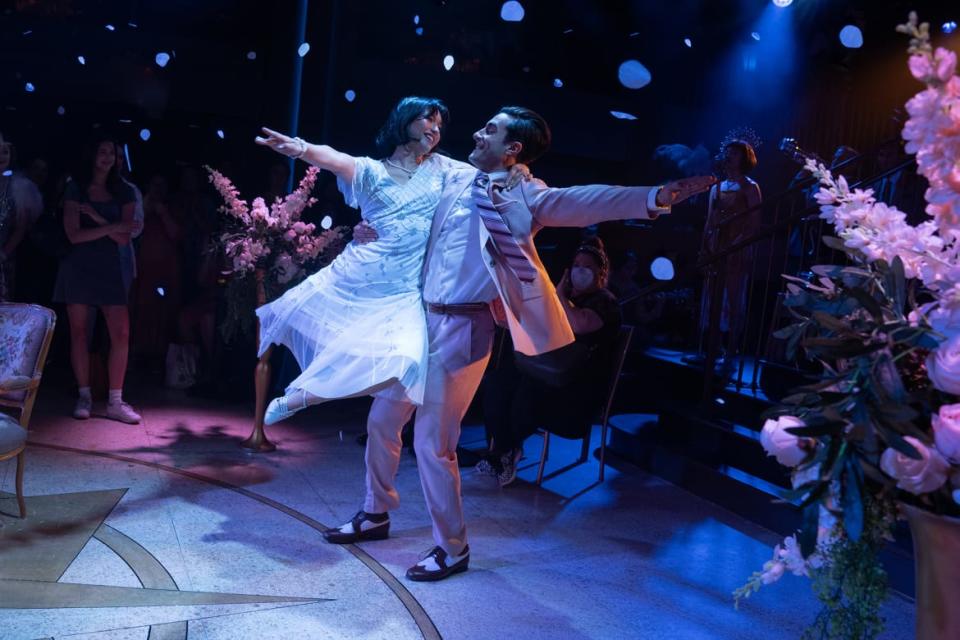
Going back nine further times would yield other revelations, and perhaps darker dramas, in other rooms. But what to do if, like us, you are just going once? Well, judging not just by the book, but also the flurries of drama on the floor, our perhaps predictable recommendation would be to try and stick close to Nick, Gatsby, and Daisy. This won’t always be possible, as you may find yourself in a clutch of people suddenly dragooned somewhere else, but once you identify those characters, sidle over to them.
Did we learn anything new about The Great Gatsby? No, not in the way that Gatz’s full recitation so stunningly opened up Fitzgerald’s text. This immersive experience is more revelry-minded, although when the world of Gatsby and the Buchanans falls apart—and the main stage is suddenly illuminated by shafts of funereal light, and Gatsby himself appears in a fateful bathing suit—it rightly slows and leans into its foundational profundity.
The play nails the Roaring 20s feel so well—manic, frenzied, youthful, precarious—that you can’t help but enjoy yourself even if you know it’s all going to come crashing to an end very soon. As the novel and the play remind us, you can’t turn back time, you can’t recapture certain youthful dreams—today’s audience can’t go back to pre-COVID innocence—and yet it certainly feels good to dance amongst strangers once again and watch the smartly-dressed Gatsby woo his beloved Daisy. So good, in fact, that we forget for a time that we’re all driving on “toward death through the cooling twilight.”
The Light in the Piazza
Encores has done it again. After Into the Woods and Parade, their stunning, shattering revival of The Light in the Piazza must, must, must go to Broadway, principally because Ruthie Ann Miles has to shine for more than a span of five nights as Margaret Johnson, mother to Clara (Anna Navelson, just as fabulous). In Craig Lucas’ intelligent, deeply felt musical, with music and lyrics by Adam Guettel, mother and daughter are in Florence, where Clara falls for Fabrizio Naccarelli (James D. Gish). But a secret medical condition could torpedo their romance.
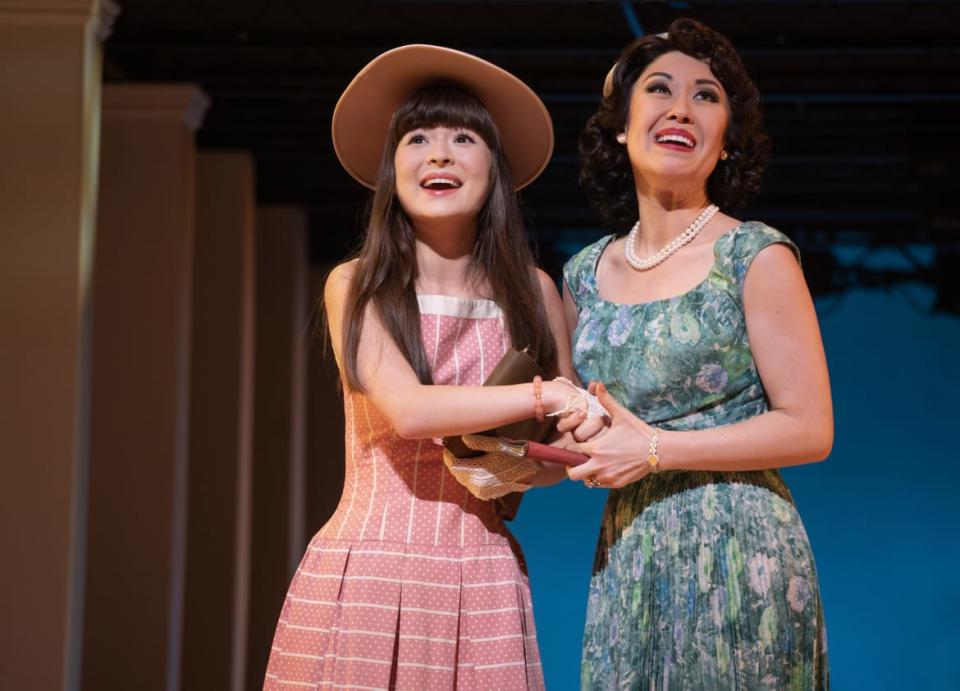
Anna Zavelson, left, and Ruthie Ann Miles in 'The Light in the Piazza.'
The story outline does not do justice to what explodes so vividly on stage—in terms of the terrain of the relationships sketched, the singing by the principals, and also a range of nuanced, delicate, witty, and moving performances under Chay Yew’s sensitive direction. Miles balances dry wit with a profound protectiveness, and finally determination to embrace romance and possibility—everything that her own marriage to husband Roy (Michael Hayden) has up to now nullified. The very funny Andréa Burns as Fabrizio’s mother supplies the most pointedly timely Italian translation on stage.
What really resonates are the unexpected, enveloping folds of the story. The joys and misery of mother and daughter, translated into soaring soprano—with Rob Berman directing a shimmeringly perfect Encores! Orchestra—left our audience elated, poleaxed, and still cheering and applauding as we headed to the exits. Put simply, to any Broadway theaters reading this: Sunday’s must not be the final performance of The Light in the Piazza.
Back and Forth
This is a lovely, uniquely New York experience, and also a mournful way to drink in a summer eve’s sunset. To see Back and Forth (Central Park, East Meadow, Fifth Avenue and 98th Street, to July 23), you sit on some grass with a pocket radio and headphones. In front of you, 100 feet away, Marty (Richard Hollman, who also wrote the play) prepares to play a game of catch in Central Park with his best friend Drew (Chris Roberti), with a baseball and two mitts.
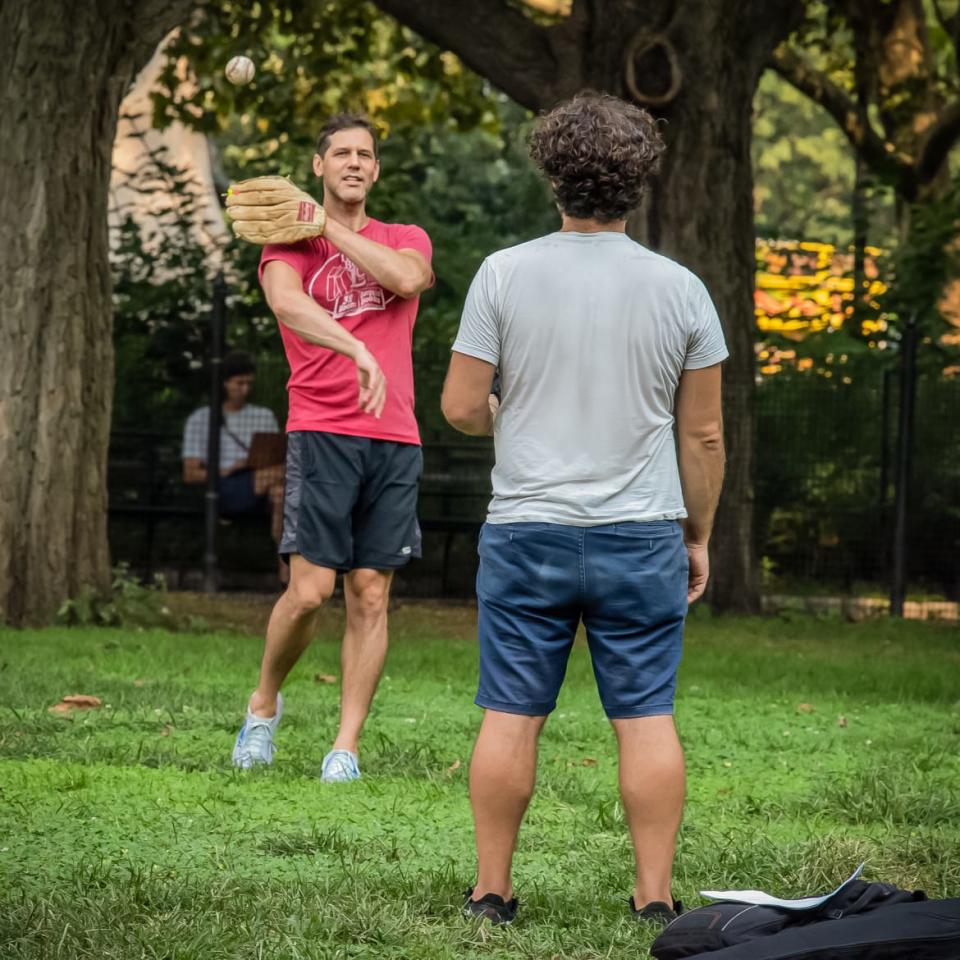
Richard Hollman, facing camera, and Chris Roberti in 'Back and Forth.'
We can hear what they are saying to each other via our pocket radios, and what unfolds over 45 minutes is a friendship in gentle, then sudden, though perhaps not deathly freefall. Part of it is down to the pandemic, and lives quietly diverging. Part of it is down to growing up and growing away from one another, as life commitments with significant others take precedent. They also joke and provoke one another, and generally kvetch as two New York buddies do, which makes the punch of their actual farewell even more winding.
The trajectory of their goodbye is mirrored—under Katie Young’s direction—with how their throwing to each other segues from long, deep, smooth throws to ones slung with more venom and anger. Around the men and walking between them—not realizing they are participating in a theater production, likely just seeing another two guys playing a game of catch—are real people on their own or in groups, with dogs, kids and playing their own games of ball. In the quietest way imaginable, the ending almost aces this season’s memorable stage exits of Jessica Chastain in A Doll’s House and Josh Groban and Annaleigh Ashford’s in Sweeney Todd.
Get the Daily Beast's biggest scoops and scandals delivered right to your inbox. Sign up now.
Stay informed and gain unlimited access to the Daily Beast's unmatched reporting. Subscribe now.

